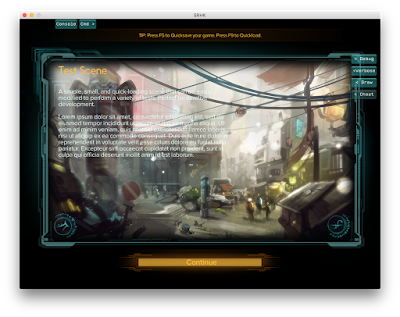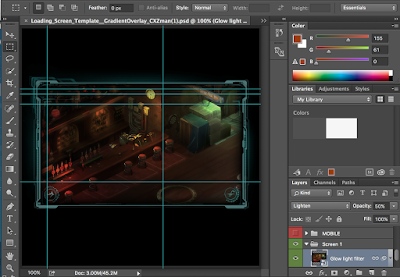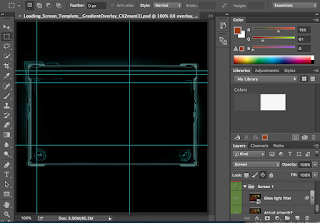I just finished the second episode of Life Is Strange: Before the Storm, "Brave New World".
It. Is. SO GOOD.
The series continues to focus on its emotional dimension, to its benefit. My heart grew so full during one particular scene. I'm so happy that we have this story and these characters.
I think my post on the
first episode was probably overly focused on the technical aspects of the game. I'll give that a pass this time, except to note that, now that more music tracks have been added, I'm starting to see the point of the "Mixtape Mode" deluxe feature. I'd probably use it if I was playing on a console in my living room, I could see leaving it on while doing stuff. On my PC, it makes less sense, and will probably remain a novelty.
Now, let's get into some
MINI SPOILERS
It's been pretty disconcerting to see the ongoing wildfires on the West Coast since the first episode came out. I'm sure this game was in production for long before this fire season started, but, man, that has been some freaky marketing. As I blogged before, the Bay Area has been suffering from
massive fires in the North Bay, and seeing the smoke rise from the in-game hills was absolutely chilling. I think my reaction to, say, the marshmallow conversation was quite a bit different than it would have been in another year when I hadn't been breathing smoke for a week or two.
I enjoy backtalk, but I think it's becoming increasingly clear that starting a backtalk is always the worst option in a situation, even if you win it. They're fun, though, so I almost always do them anyways. It might seem odd to have a challenging thing lead to a worse outcome, but I actually love that kind of game design - it reminds me of Failbetter Games. My streak here continued. I think I lost one point in a backtalk with Wells, and another with Frank, but still won the overall contests. The one with Skip was
awesome. I passed on the last opportunity to backtalk in this episode, though I may try it if I replay.
Speaking of which: I did end up replaying the first episode before this one, but didn't make any major changes to the canon: I stole the money and gave it to Joyce, and was a bit nosier in poking around, but that's pretty much it. In the replay I wore the Illuminati shirt instead of my earlier Punk Doe; I'd been planning on going back to Punk Doe for this one, and was delighted to see that there are an entirely new set of non-Deluxe outfits available. I ended up rocking a jacket. It looks cool, but more importantly, it's Rachel's, and that's... just so awesome.
It's awesome to see Chloe sort of growing and changing in some ways as a result of her time with Rachel, but it's also great to see her still being very much herself. There were a whole bunch of literal laugh-out-loud moments throughout this episode, often a direct response to Chloe's words or actions. Her going ham on the bathroom was so great.
MEGA SPOILERS
Pompidou is so cute!
So, one thing about BTS is that... I'm not really sure what the story is? Even though we're now 2/3 of the way through the game (sob), I don't know what the main plot or motivation is. Is it about how dangerous Damon is? It feels like they're setting stuff up, but Chloe seems to have only tenuous and vague connections to the various players, and doesn't have a strong personal interest in most of it. She's an observer and reactor, not an active agent in chasing down what's going on.
Which is weird, since it's the opposite of the first season. Character-wise, Max tends to be much more withdrawn and quiet and observant than Chloe; but game-wise, by the end of the first episode, Max had a clear set of goals: solve the mystery of Rachel Amber and prevent a tornado from destroying the town. Chloe's character is much more brash and direct and outspoken, but unlike Max, she's mostly wandering around, passively listening to the things people tell her.
That probably sounds like a complaint, but it's really an observation. The fact that this doesn't feel like a detective story or a thriller means that it ends up being mostly a love story, and I am 100% okay with that. Almost by default, the main story ends up being the budding relationship between Rachel and Chloe. And that's really what people loved about the first Life Is Strange: the plot and the rewind mechanic were cool, but we're so devoted to it because of the amazing characters and their relationships.
And, on a more practical note, they can't do anything
too crazy here or it would seem weird that Chloe never brought it up in the main series. I mean, everything that's happened so far fits comfortably under the rubric of "Arcadia Bay sucks, Rachel and I wanted to run away." If they brought in, I dunno, space aliens or immortal Prescotts or a manifesting Topanga, then Chloe would have at least mentioned it in passing in the discussions about how boring her town is.
That actually relates to another thing I've been thinking about. As I mentioned way back in my
initial post on Life Is Strange, I kind of suspected that Rachel Amber might have had rewind powers as well, as it would explain her preternatural ability to fit in with all the various cliques of Blackwell. The first episode of Beyond the Storm seems to subtly reinforce this theory, as in the "two truths and a lie" game on the train: even if you do something unusual like two lies and a truth, Rachel still figures it out. Now, granted, it's definitely possible that Rachel really is that good. BUT, we also know, within this game's universe, exactly how someone like Max would have "solved" that problem which Chloe presented.
This is all circumstantial, of course, and to a certain degree it doesn't matter. There is a 0% chance that we will learn in the next episode that Rachel has the rewind power because, again, Chloe is our only viewpoint character, and if
she had learned that Rachel had the rewind, she
definitely would have mentioned it when Max turned out to have it. It's possible that there will be some in-game indication to the
players that this is the case, but I think it's much more likely to remain in the realm of "possible but unproven fan-theory".
Except...
I have absolutely no justification for this, but I recently developed a crazy prediction for the upcoming "Farewell" episode. It started with me speculating about the casting for it: hopefully, now that the strike is over, they can bring back Hannah Telle to voice young Max again. But will they bring back Ashly Burch for Chloe, or keep Rhianna?
My crazy theory is that they could develop a
split timeline in this episode. Possibly as a side-effect of future-Max traveling back in time, perhaps for some other reason. Again, we have evidence within the game universe of how possible realities can split and coexist. We happen to be occupying a "prime" reality, but the other realities don't disappear, we just aren't in those right now.
All that being said: it might be really clever and not-too-cheating to have
both Ashly and Rhianna present, and each voice Chloe in their own separate timelines. The Ashly one leads into the first-season-canon Life Is Strange, and all the heartache that entails. The Rhianna one leads into the Before The Storm timeline, and, thanks to the butterfly effect, does
not necessarily have the same outcomes. Perhaps Jefferson never comes to Blackwell, perhaps Chloe and Rachel leave town. That would help with one major problem people have with Before The Storm, knowing what happens to these characters later, and, maybe, open up the possibility of even more adventures in the future.
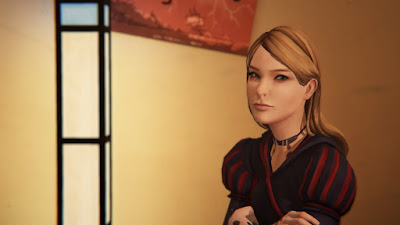
So, yeah... obviously, I've been enjoying the series immensely, and have been feeling regretful that it's a truncated one. Particularly given what seems to be a (relatively) low-stakes plot, I've been curious if Deck Nine and/or Squenix are thinking about franchising Before The Storm, in addition to the core DONTNOD Life Is Strange. I can imagine a scenario where one team continues telling more realistic stories in Arcadia Bay while another team does more supernatural stories in new areas. After the first episode, my tentative thought had been that they might be setting up characters to do a spinoff series: Steph, Mikey and Drew are obvious candidates, as they don't appear in the main series and would be free to go off and have their own adventures. After the second episode, though, I'm increasingly wondering if we might get another prequel season of Chloe and Rachel. Even without my crazy alternate timeline, we still have two years before Max comes back, and there could be some more good stories in there.
(And, again, I'm curious how the business side would affect all that. Now that the SAG-AFTRA strike is over, will they be getting union actors? What does that mean for characters like Steph? I'm not familiar enough with the business to know if they can just join the union - I'd imagine that working a struck project would be frowned upon, but given that they already voiced those characters, it would be nice to have them again for this entirely-hypothetical continuation.)
But, yes. Fundamentally, I just really, really like seeing Rachel and Chloe together. They have amazing chemistry, and the arc of their romance is really sweet. They do a great job at showing this in all dimensions. My heart skipped happily when reading through the texts from the previous night - Chloe, who is usually so standoffish with others, and so needy and unfulfilled in her interactions with Max, finally has someone who freaking
texts her back, and their contagious excitement as they blast messages back and forth at two in the morning is... ugh, it's so, so good. And the way Chloe opens the door to her truck for Rachel, her mixture of nervousness and pride, Rachel's subtle attitude of ownership ("You look damn good in my clothes!"), their sense of concern for each other as they navigate stressful days...
But most of all the Tempest itself and the walk home afterwards. Wow.
To start, Chloe's line-reading slays what might just be my favorite exchange in the entire game:
"What if I told you that the entire fate of the production rests upon your slender shoulders?"
"I'd say: 'You're super-f*cked!'"
Memorizing and delivering the lines was a lot of fun - it was pretty obvious how stuff was going to go down, so I went over the script a couple of times. (I have read The Tempest before and vaguely remember the plots/characters, but definitely don't have the lines down!) This reminded me a bit of the famous Opera House scene in Final Fantasy VI, which (SPOILER ALERT FOR CALFREE IN CHAINS) also inspires an optional sidequest in CalFree In Chains.
Anyways, the way it actually goes down is really cool - I was expecting to just need to give the first line of each response, so it was cool that they mixed it up a little, with you sometimes needing to deliver a later word ("troops") or hit a stage mark. And Rachel's on-the-fly script revision was incredible, giving me butterflies in my stomach. (Though, I have to say, editing the bard takes a lot of guts! Kudos to the writers for going there.)
And, the walk home... happy sigh...
Oh! I forgot to mention this above, but here's how devoted to the game I am: I actually bought a controller specifically for it. I've been a happy KBM user for my entire life, and have left controllers to the rare occasion that I use my Playstation. But I was reading a comment about episode one, where someone mentioned how devastating the junkyard scene was with the vibrations of the controller, and I thought "OH MAN I NEED TO EXPERIENCE THE GAME IN THAT DIMENSION TOO!" So I bought an xbox controller and... yeah. It seems like such a little, dumb thing, but I think the sensation of touch is REALLY important, and it's used so well in this game. Little nudges from Rachel, carrying through into your hands, forging yet another connection between her and Chloe. Happy sigh.
A few final (for now) random thoughts:
I'm curious about what Eliot's deal is. At first I thought he was just the "prequel Warren," but the game seems to be implying that there's something darker going on. In one of her early journal pages, Chloe mentions that she sometimes feels like he's studying her. Samuel has a
fascinating series of comments about Eliot which make it seem like he's almost supernatural, or maybe metatextual. I've been consistently and politely turning him down at each opportunity, and initially skipped over his dorm room; after finishing the episode, I used Collection Mode to get the graffiti outside his room, and found the stuff inside. It's... maybe not exactly a smoking gun, but it's hella creepy.
All that being said, is it going anywhere? My current guess is that he's a red herring, similar to Sean Prescott in the first season of the game. He seems important, but I don't see how he would fit into any of the major plot lines for the final episode.
Oh, speaking of Sean Prescott: it was super-interesting to have him show up for this! I wasn't expecting that at all. Honestly, it almost seemed like a bit of a waste... he's been such a larger-than-life behind-the-scenes villain, and it was a bit anticlimactic to just use him to chew out Nathan. But, I dunno, maybe that is the point.
So: one thing that Life Is Strange is unusually good at is drawing a line between empathy and sympathy. There are quite a few characters who are awful, but the game (eventually) gives you an understanding of how and why they are this way. BUT, it's still up to you as a player to decide what to do with that information. After all, just because someone has a reason to be that way doesn't cure the harm they have caused.
I seem to be on the less-forgiving side of things. I'm a hardline anti-David-er; judging from the end-game choice breakdown, I'm in the minority of players who continue to resist David's intrusion into the Price family. I think that for a lot of players, after they've seen David's entire arc through Episode Five and understood that he really does care for Chloe and is ultimately motivated by good aims, see him in a much better light and want to side with him. For me, though, I still see the abusive stepfather who batters his stepdaughter and violates her privacy and drives a girl close to suicide. He might
want to be good, but he
does bad, and I don't think it's fair for Chloe and the other people in his life to put up with his bullshit and his shortcomings.
That same dynamic is at play with me and Nathan. I actually have more sympathy for Nathan than for David, probably because we can more easily see and name the cause of Nathan's issues. But Nathan has (by the time of LiS) done even worse things than David, and, while I feel really bad for the kid, I'm...
Well, let's talk about Samantha. Looking at the post-game stats, I was shocked to see that I was one of only
2% of players who had advised Samantha to stay away from Nathan. I had expected to be in the minority, but not that small of one! I mean, as players, what do we know about Nathan? He drugs and rapes young women, and has (accidentally) killed one. Granted, in-game Chloe doesn't know this; but we know from her journal that she senses how weird he is, and in all of our interactions with him, he's never said anything kind, and always lashes out in anger at anyone who tries to help or support him.
It isn't necessarily bad that Samantha feels sorry for him - she has a kind heart, and almost definitely a crush on him, and neither of those things is bad. But... argh. I think my main obstacle is this idea that women can or should fix broken men. Don't! If he's an asshole, don't try to change him! It's not his fault that he's an asshole, but it's
not your job to fix him. But, somehow, 58% of players wanted to move these two closer together.
One of the final images in the episode, right before the closing credits, shows Samantha, standing alone in the dark, smiling at Nathan as he approaches her. I'm guessing that that 58% of players thought it was sweet. I shivered. I
hope that it works out, but I really wish that she had taken my advice.
Last but not least, the big revelation at the end. I'm still mentally processing the idea that Sera is Rachel's birth mom. In some ways, it makes sense... I hadn't thought that they looked all that similar, but I guess they do have somewhat similar builds; more relevantly, Rachel doesn't look much at all like either of her parents. At first I thought she might have been adopted; but the kissing would imply that Sera was a former lover. (Probably not an ex-wife, but maybe so, who knows.)
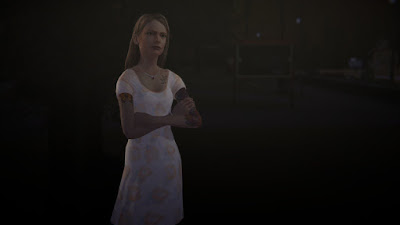
From looking at the files in the Amber home, we also see that Sera is involved in Damon's criminal enterprise, so I'm sure that's somehow connected. When I first saw that, I thought "Oh, maybe she's a mole on the inside, and Mr. Amber is trying to bring them down". But that doesn't make sense: he's a district attorney, not a detective; he charges cases, he doesn't investigate them. So, is it the flip side? Is she blackmailing or manipulating him to get information on the government's case to protect the gang? Frank mentioned that she had shown up relatively recently, so it seems likely that she's connected one way or another.
And, y'know... who
is she? She probably isn't just a junkie, given her position on the chart. Maybe a mid-level dealer or operative of some sort. But there's that chilling image of her smiling and smoking as the fire burns at the end of Episode One. If - if! - Rachel does have some sort of supernatural powers, is it possible that they came from her?
In any case. She's almost certainly the final slot on the cast-of-characters sheet, and I imagine we'll learn a lot more about her in the next (final (sob) ) episode. And I'm sure it'll be a huge development for Rachel as well, though I'm not sure yet how she will react. Will this postpone the plans to exit Arcadia Bay, as she tries to connect with this previously-unknown element in her past? Or further drive her determination to escape and define her own destiny? I dunno. I want to find out!
END SPOILERS
Okay! That was fun! I've been on a mini-media-quarantine for a little while. Starting shortly before Episode 2 dropped, I unfollowed all of the Life Is Strange social media feeds and various individuals associated with the productions who I follow. Despite the episode leaking almost a week early on XBox, I managed to finish it with encountering zero spoilers, hurrah! I'm eagerly looking forward to diving back into the fandom to see the many, many things that I overlooked during this playthrough. I also predict that we will be seeing a
lot more Shakespearean fan art in the coming weeks, and don't want to miss any of it.
Despite my earlier optimism, I never did get around to sorting and captioning my Episode 1 screenshots, sorry. I pulled out a couple of Episode 2 shots for this post, but the rest of them will probably be waiting for quite a while longer. At this point, I'll probably just wait until all three episodes are out and then come up with proper albums for them.






































